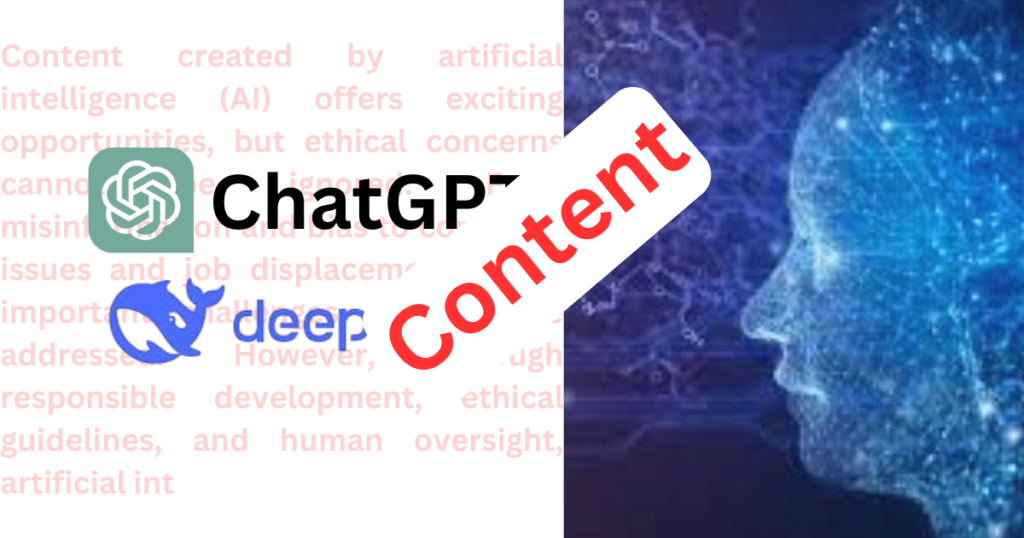AI-generated content is a major challenge to human creativity, revolutionizing industries from healthcare to entertainment. One of the most exciting—and controversial—applications of AI is content creation. Artificial intelligence-generated content is everywhere: from blog posts and social media captions to news articles and even novels. But as this technology advances, so too do the ethical concerns surrounding it.
In this article, we will dive deep into the ethical dilemmas of artificial intelligence-generated content, explore its impact on society, and discuss how we can navigate this brave new world responsibly. Whether you’re a content creator, a consumer, or someone interested in the future of technology, this is a conversation you won’t want to miss.

Table of Contents
What is AI-generated content?
Artificial intelligence tools refer to any text, image, video, or audio created using artificial intelligence tools.Tools like OpenAI’s GPT model, DALL·E, or Jasper use machine learning algorithms to analyze vast amounts of data and create content that mimics human creativity. The results can be surprisingly realistic – so much so that it’s often difficult to tell whether it’s human-made or machine-made.
While this technology offers incredible benefits, such as time savings and increased productivity, it also raises important policy questions. Let’s explore some of the key concerns.
1. Plagiarism and Intellectual Property Issues
The biggest ethical concern when it comes to AI-generated content is plagiarism. AI models are trained on huge datasets that include books, articles, and other creative works. This raises questions about ownership: Who owns the content created by AI? Is it the developer of the AI tool, the user it prompts, or the original creators’ work that was used to train the model?
For example, if an AI creates a poem that resembles the style of a famous poet, is that plagiarism? And what happens when AI-generated content is used commercially without proper attribution? These questions challenge our traditional understanding of intellectual property and copyright law.
2. Bias and discrimination in AI-Generated Content
AI models are only as good as the data they are trained on. If the training data contains biases—whether racial, gender-based, or cultural—the AI is likely to reproduce those biases in its output. This can result in discriminatory or offensive content, which can perpetuate harmful stereotypes.
For example, an AI trained on biased hiring data could create job descriptions that favor one gender over another. Similarly, an AI trained on biased news articles could create content that unfairly targets certain groups. Addressing these biases is crucial to ensuring that AI-generated content is fair and inclusive.
3. Misinformation and fake news
Content created by artificial intelligence (AI) has the potential to spread misinformation on an unprecedented scale. With tools that can create realistic news articles, social media posts, and even deep fake videos, bad actors can easily manipulate public opinion or spread false information.
Imagine a scenario where an AI creates a fake news story claiming that a celebrity said something controversial. If the article goes viral, it could damage reputations, cause panic, and even influence elections. The ease with which artificial intelligence (AI) can create believable fake content makes it a powerful tool for deception.
4. Human Employment and Creativity and economic impact
AI-generated content is already being used in copywriting, journalism, music composition and digital art, raising concerns that human creativity may be being devalued in favor of cheaper, automated alternatives.
While artificial intelligence can undoubtedly increase productivity, it also threatens to displace human workers, especially in industries where creativity and originality are highly valued. This raises ethical questions about the responsibilities of companies using AI: Should they prioritize profits over people? And how can we ensure that AI complements human creativity rather than replaces it?
5. Lack of transparency and accountability
Many experts advocate clearly labeling AI-generated articles, videos, and images. Social media platforms and news outlets should disclose whether AI was involved in the creation of the content.
For example, if a company uses AI to create product reviews or endorsements without disclosing them, consumers may feel confused. Similarly, if a news outlet publishes an AI-generated article without labeling it, it could undermine the credibility of journalism.
6. Ethical AI: Finding the Balance
AI-powered content will persist, but ethical issues must be addressed to ensure responsible use. Here’s how-
- Developing bias-free AI: AI models need to be trained on diverse and inclusive data to reduce bias.
- Stronger regulation: Governments and technology companies need to work together to establish clear policies for artificial intelligence-generated content
- Air Compensation: Content creators should receive recognition and compensation when artificial intelligence-generated content is taken from their work.
- Transparency and accountability: Companies using AI should be transparent about how their models generate content and accept responsibility for any mistakes or policy violations.
7. Ethical Use in Education
The use of AI-powered content in education is growing, from automated essay grading to personalized learning tools. While it can make education more accessible and efficient, it also raises ethical questions.
For example, should students be allowed to use AI to write their essays? If so, how do we ensure they are still acquiring critical thinking and writing skills? And what happens when fake research papers or academic articles are created using content generated by artificial intelligence (AI)? These challenges highlight the need for clear guidelines and ethical standards in the education sector.
Conclusion
Content created by artificial intelligence (AI) offers exciting opportunities, but ethical concerns cannot be ignored. From misinformation and bias to copyright issues and job displacement, many important challenges need to be addressed. However, through responsible development, ethical guidelines, and human oversight, artificial intelligence can enhance creativity rather than replace it.
